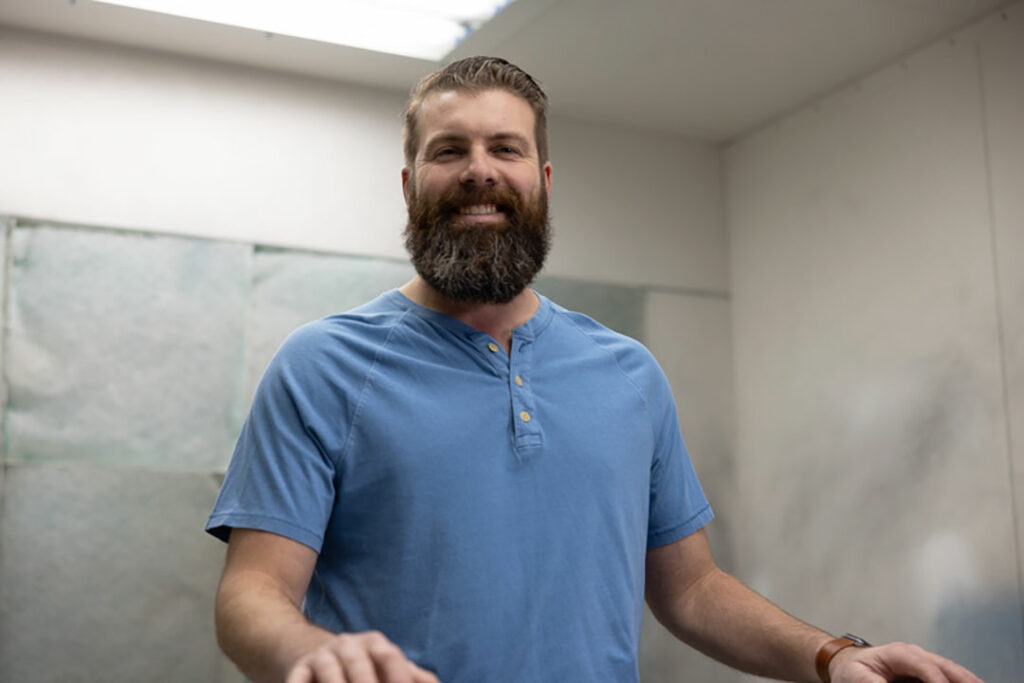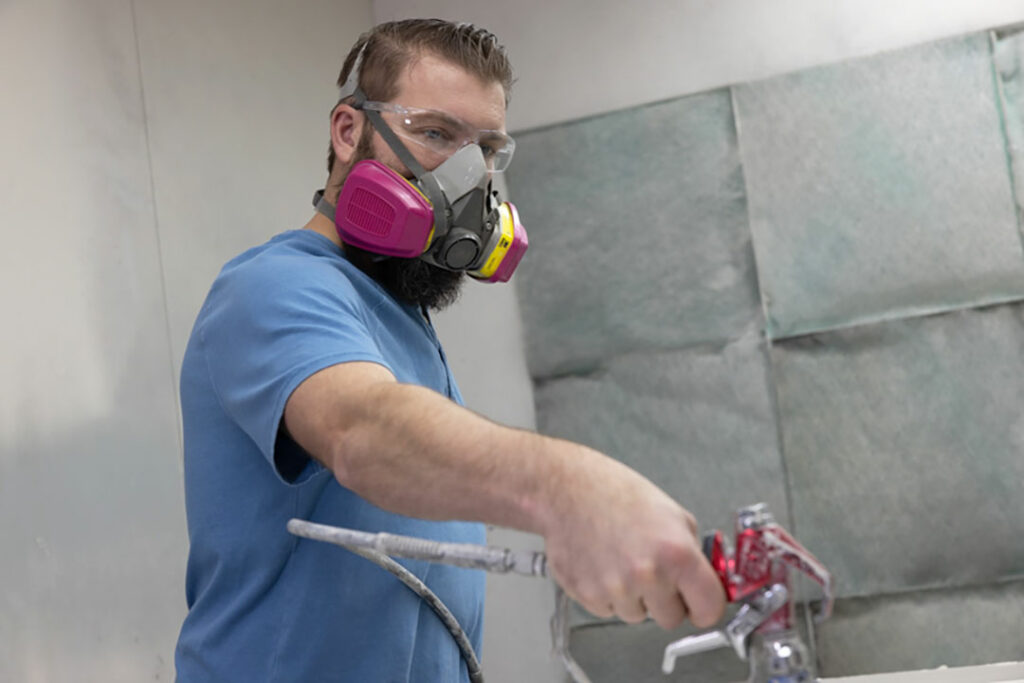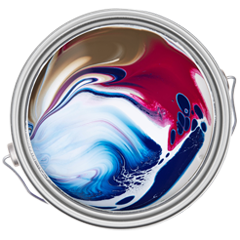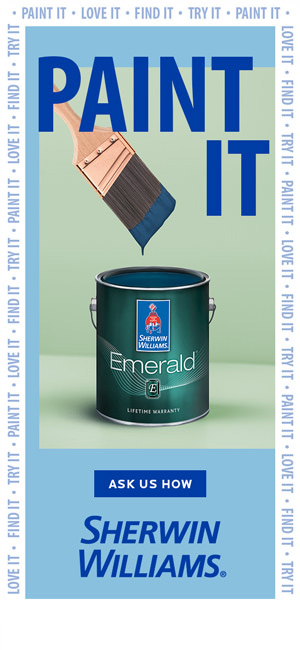Have you been searching for more helpful hints on how to better complete your DIY projects? Look no further! We sat down with professional painter, Nick Slavik, who shared his tips of the trade in our Q&A.

Nick Slavik of Nick Slavik Painting and Restoration Co.
Q: Craftsmanship is at the heart of everything you do. Can you tell our readers how you got your start in the world of painting and where you’re at with the trade today?
A: I got my start at an early age when my dad got me into working for the family business. I spent countless evenings, weekends and summers learning the ropes as I was well on my way to being a Craftsperson. After I graduated high school, I joined the army for four years then went to college for business and came home with plans to rejoin the family business. When there was no space for me there, I started my own business.
It has been an amazing 14 years of mastering the craft and learning what it is to be a leader. We now not only employ around 50 people, but also have a great leadership team, finishing/training facility and an industry-leading apprenticeship program. The young apprentices we’ve hand selected and trained have won more than 15 national awards for their talent and most with only a few years of trade experience.
Q: There’s no shortcut to a perfectly painted space – why should you never skimp on prep work?
A: Prep is everything. After 29 years, it still amazes me that priming is almost an afterthought of most projects. On average, we can spend up to 50 hours enameling a set of kitchen cabinets, while it only takes four and a half minutes to put a coat of paint on them. Prep doesn’t have to be a tedious task, but it’s definitely something that makes the final result worth the effort.

Q: What’s a common paint myth every DIYer should know?
A: One myth is that all exterior paint and stain projects age the same. Exterior paint will last about seven years on average, but it ages and wears differently on various parts of the house. For example, a shady area may have 10-20 years before a re-paint is needed versus one to three years in a sunny area. It’s also important to have realistic expectations for these projects, too. To get a ‘natural or cedar’ translucent wood tone, you will have to coat the material every one to two years to maintain the look, but it’s easier to maintain results rather than having a full restoration in 18 years.
Q: To DIY or not DIY – what advice do you have for homeowners on the fence about doing a project themselves vs. calling in backup?
A: Absolutely do it! I love that people still do their own projects, but there is confusion on coating selection and process. There is a new breed of trade professionals out there who are more open to questions and willing to explain the process beforehand. If you want to DIY a project, but want advice from a pro, be upfront and honest about your intentions. Most businesses are single person companies and do estimates in the evenings and weekends, so be respectful of their time. If someone puts an inquiry through my website and asks what primer or paint I use on cabinets I will absolutely offer that advice. It only takes a minute or two and it’s not a trade secret. It’s just the decent human being thing to do.
Some other quick advice: Buy a good brush and a good roller and the best paint you can afford. Materials are very inexpensive compared to your labor and will pay dividends in the quality of the paint job and your enjoyment while doing it!

Featured Color: Repose Gray SW 7015
Q: Do you have a painting trick (or two) up your sleeve that our readers can use for their next project?
A: Here’s a super sneaky tip from a pro. An even, professional finish is created by keeping the edges of the area that you are painting wet, aka a ‘wet edge’. Think of painting a bedroom wall, you should paint close to the edge of the wall, but only as far as you can before the paint dries. While this center paint is still wet, paint the edges to keep a continuous wet edge. It will dry evenly and prevent unwanted painting fiascos.
Another tip is to use painter’s tape and apply to the trim of where you are painting. When applying, press the edge of the tape nearest the wall down with a putty knife or five-in-one tool. Doing this effectively will help prevent bleeding and/or touch ups needed when you’re done!
One other thing to keep in mind is that there are no real paint emergencies. Most things can be fixed or repainted. Don’t beat yourself up about a less than stellar outcome. Just learn a lesson and don’t repeat it!

Featured Color: Repose Gray SW 7015
Q: What advice do you have for beginner DIYers that want to take their painting skills to the next level?
A: There are amazing resources out there that did not exist a decade ago. Two good places to start are the Painting Contractors Association (PCA) and Ask a Painter Live.
The PCA is North America’s premier trade association for painting contractors. They are the holders of the industry standards, a great resource for craft content and a substantial directory of the finest Craftspeople in North America.
Ask a Painter Live is my weekly live show on Facebook, Instagram and YouTube with over 300 shows in total. I have dived into the depth of every corner of the craft and show viewers how a pro does these projects.
Which Sherwin-Williams paint is your favorite to use for interior projects?
A: One of the best paints I’ve ever had the pleasure to use is Sherwin-Williams Duration Home® in matte. It covers, lays out nicely and has a sophisticated sheen for walls.
Want to put these tips to the test? Get inspired with some of our favorite projects and read more helpful articles featuring tips and tricks that can help you tackle your next DIY!











I have a great tip for diy for painting? When painting over a
Darker color. Tint the primer to
The base color you choose over the darker walls.
Yes, great tip Sandy!
I would like to enter the sweepstakes! I cannot find the link.
this was so informative, so much so I saved it to use as a future reference on next project !
Awesome, so glad to hear it! Best of luck on your next project!
Everyone says to buy a good brush and roller but What should I look for in a good brush and roller
Quality is most important here, you don’t want the cheapest option but you don’t necessarily need the most expensive one either. We recommend for smooth walls a Purdy White Dove 3/8 nap roller (9 inches typically). For surface with some texture, we recommend a 1/2 nap and so on. For brushes, here is a guide on how to choose the right brush for your project. We think Purdy has some awesome brushes though! https://www.sherwin-williams.com/homeowners/sw-article-dir-intchoosebrush
Best exterior door paint and application?
Hi there, we recommend our Emerald Urethane for exterior doors. If they are painted you can just use this paint, if they are bare, you will want to sand and prime with a bonding primer first. When rolling, we recommend a 3/8 nap. Our black foam rollers or mohair rollers will give you a smooth finish!